Ethics and Morality
The Polarization of America
Each year, we become more fractured and more polarized.
Posted August 14, 2018 Reviewed by Abigail Fagan
In 1992, a high proportion of counties in the U.S. were basically politically heterogeneous, meaning that there was a mixture of people with different political orientations. So in 1992, if you threw a dart at a map of the U.S., you’d have a good chance of hitting a county that had a relatively balanced ratio of Democrats to Republicans.
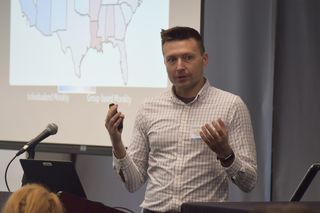
Based on some provocative data recently presented at the Heterodox Psychology Workshop by social psychologist Matt Motyl (2018), this situation has changed dramatically in a generally linear fashion since 1992. The graphs presented here, which come directly from Dr. Motyl’s presentation, tell the tale. In each map, WHITE represents a county where the winner of the presidential election for that particular county won by less than 20 percentage points. RED represents a county in which the Republican candidate for the presidential election for that particular county won by more than 20 points. And BLUE represents a county in which the Democratic candidate for the presidential election for that particular county won by more than 20 points.
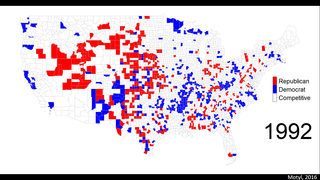
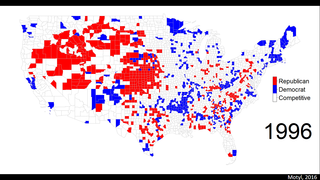



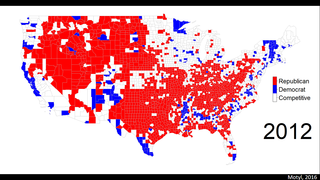
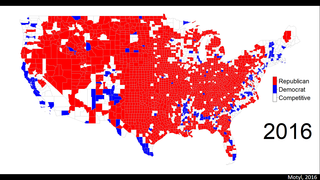
As you can see, the map in 1992 is largely white. Thus, back then, a high proportion of counties included a relatively even mixture of Democrats and Republicans (which maps, loosely, onto what we might call progressives and conservatives).
But for various reasons, things started shifting toward polarization from there. Check out the trend in the coloration of these maps (produced by Dr. Motyl himself in terms of four-year increments). They are pretty much less white each year. Red sections of the map become redder while, generally, blue sections of the map become bluer.
For my money, this polarization trend explains an awful lot about what is going on in the United States today. If you’re like me (and some of you are and some of you are not, which is a lesson that we all need to regularly internalize), then you live in a very liberal area within a very liberal state. Your friends nearly all identify as socially and politically progressive. And you genuinely stand with progressive values. Further, you might find values that are incongruous with these progressive values as hard to understand—as in, “I can’t believe that anyone would hold the opposing view!”
As I see it, this is the problem with America now. We are a polarized people and we are surrounded by those who agree with us on a daily basis. So when we hear people espousing “the other” views, we truly don’t understand it. After all, we live in our own bubbles surrounded by people who agree with our view of the world lock, stock, and barrel.
Moral Ecology and Political Geography in the U.S.
As Dr. Motyl puts it, that’s not all. In research that Dr. Motyl has done on what he calls moral ecology, it looks like the nature of moral reasoning, which varies on a continuum from individualized morality to group-based morality, maps very strongly onto political orientation—and this correlation literally maps onto the political orientation maps that Dr. Motyl developed.
Individualized morality includes a focus on what is best for individuals. Someone who is high in individualized morality cares deeply about the rights of individual people. So, for instance, in terms of the value of respect for authority, someone who is high in individualized morality might believe that, in fact, we are all equal as individuals, and, thus, that respect for authority is not a truly and completely moral value.
On the other hand, someone who is high in group-based morality focuses more on what is best for one’s group (think America First). From this perspective, deference to authority is a deep and critical moral value.
Check out this next figure that comes from Dr. Motyl’s presentation. This figure speaks to how polarized we are as a nation in terms of the moral value of respect for authority. In the Northeast, in places such as New York and Massachusetts, people tend to think about respect for authority in terms of individualized morality. In fact, the state motto of New Hampshire is this: Live free or die. That phrase captures the concept of individualized morality perfectly.

In the middle of the country, famous for being a bastion of political conservatism, people tend toward a group-based approach to moral ecology, underscoring respect for authority as a critical moral value.
Importantly, this same trend for moral ecology to map onto political geography was found for a broad array of moral values in the research conducted by Dr. Motyl and his colleagues.
Groupthink and Modern America
So if you’re like me and are trying to see how we can help push our country onto a more amicable and positive path, then you’re constantly thinking of ways to reduce us and them thinking. Based on the data that Dr. Motyl has presented, the battle is more of an uphill battle than it has been in a long time.
Decades ago, famed social psychologist Irving Janus (1971) developed the construct of groupthink. Groupthink is a common social psychological problem associated with group decision making. Often, group decisions are made by homogenous groups—groups with members who tend to think like one another. Groups in which members pretty much hold the same values and have similar kinds of life experiences as one another. In such contexts, group polarization tends to happen pretty quickly.
Well it turns out that groupthink can be disastrous. When a small group of like-minded individuals is charged with making a decision that will affect a broader population that is relatively heterogeneous, things don’t always go well. The prevailing narrative within the group may well be highly mismatched from many of the other narratives that are held by folks outside the room. This is often why things go south when it comes to national and international politics. This is often when wars start between nations.
Groupthink is a problem. And the more polarized our nation becomes ideologically, the more we find ourselves engaging in groupthink without even realizing it.
The Open Mind Initiative and the Future of the United States
I have to say, I’m impressed with Dr. Motyl’s work. Not only did he vividly demonstrate the problem when it comes to the polarization of the U.S., but he also has worked on some plans to fix it. Toward this end, he has been part of an initiative called OpenMind. This program is designed to bring people from various backgrounds and political orientations together in an effort to reduce polarization and to increase mutual understanding.
Preliminary data that Dr. Motyl presented, in fact, show that this program has the capacity to increase such positive outcomes as perspective-taking and liking for the outgroup among self-identified progressives and conservatives. While there are several specific aspects to this program, the foundation is simply getting people from different ideological backgrounds into the room together to talk. Since our nation is so divided as a function of geography these days, it seems to me that such a program, that includes intentional interactions among those with varying perspectives, in a positive and constructive context, is a step in the right direction.
Bottom Line
The country right now is divided, quite literally. And increasingly more each year. While people vary from one to another on all kinds of ideological issues, at the end of the day, people are people and we all have a ticket on the same ride. While we work together as a national community to help get our country back on track, it will be imperative for us to realize the nature of the fractured and polarized attitudes that characterize people across the nation. We can only work toward solutions when we understand the nature of the problem. I think that the graphs from Dr. Motyl’s work presented here have the capacity to shed light on the nature of the problem by leaps and bounds. And this research also, I think, has the capacity to help us figure out where to go from here.
References
Janis, I. L. (1972). Victims of Groupthink: a Psychological Study of Foreign-Policy Decisions and Fiascoes. Boston: Houghton Mifflin.
Motyl, M. (2018). How Ideological Context Influences Psychological Research. Invited Presentation for the Heterodox Psychology Workshop. Orange, CA.




